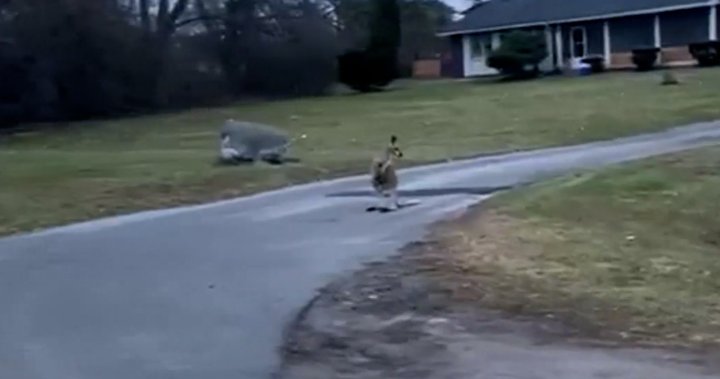A new exhibit has opened up at the Mah Society of Edmonton, taking visitors through more than a century of Chinese-Canadian history.
The Journey of the Horse was created by Sue Mah and Andrea Maru.
The two met on a heritage tour in 2019 back to their ancestral village in southern China, where they both inspired to share their family’s history and the hardships early Chinese settlers to Canada experienced.
“The title is a play on words,” Sue said.
“Our surname ‘Mah’ in Chinese means ‘horse’ and so I wanted to depict the journey the men and a few women, how they came across the Pacific from China to Canada in the late 1800s and early 1900s, and also show the struggles that they had, as well as facing the discrimination and racism in the early 1900s towards the Chinese and also to show the successes as well.”
The exhibit details their struggles, the racism they faced, how immigrants integrated with education and why they were forced to start up businesses to make a living.
“They were not allowed to be professionals — the only way for them to make money was open up their own businesses,” Sue said, leading to many immigrants opening up stores, laundromats and Chinese restaurants.
“A lot of us Mah’s had grocery stores and cafes and restaurants all across Edmonton and surrounding area.”
The Mah Society of Edmonton was created as a support group of sorts: many of the Chinese men who moved to Canada were forced to leave their wives and children behind.
The society was formed in 1917 to combat loneliness and foster camaraderie and relationships amongst the new Chinese immigrants, many of whom were railroad workers with the last name Mah, Ma, or Mar.
“It was a brotherhood — a family.”
Chinese immigrants to Canada faced many barriers in the late 1800s and the first half of the 1900s.
Breaking news from Canada and around the world
sent to your email, as it happens.
A head tax was enacted between 1885 and 1923 to restrict immigration after cheap Chinese labour was no longer needed to build the Canadian Pacific Railway. It was the first legislation in Canadian history to exclude immigration based on ethnic background.
With few exceptions, Chinese people had to pay at least $50 to come to Canada.
The tax was later raised to $100 in 1900, then three years later to $500 — roughly equivalent to two years’ wage for a Chinese worker, which the Mah society said prevented many men from bringing their families over to Canada.
The head tax was removed with the passing of the Chinese Immigration Act in 1923, which was even more devastating. Also known as the Chinese Exclusion Act, it banned all Chinese immigrants until it was repealed in 1947.
In 2006, the federal government apologized for the head tax and its other racist immigration policies targeting Chinese people.
“The reason why we’re here is because of these brave men who trudged through all this stuff just to bring us here,” Sue said.
Hoy Sein Mah, now 90, journeyed to Canada from China when he was 16. He arrived in May of 1950 and was reunited with his father, who first came over in the 1920s.
Edmonton’s spring weather was a rude awakening after growing up in southern China.
“Cold cold cold — shaking — quickly bought a coat to wear, it was so cold,” Hoy Sein said. He was one of the few Chinese youth in Edmonton at the time.
“The only Chinese going to school. They didn’t know what to do — they phoned everyone in the town and nobody accepted me,” he said.
He learned English working at his father’s store after school, through special classes, using a Chinese-English dictionary, and when he was hospitalized with tuberculosis.
Hoy Sein is happy to be sharing both his journey, and that of other immigrants, to a wider audience.
“It’s very nice that people will learn the Chinese history from us.”
Once children and families could join their fathers in Canada, Sue said they successfully assimilated into Western culture.
Sue was born in China and immigrated with her parents to Edmonton when she was six years old. She said they joined her grandfather, who immigrated to Canada over a century ago.
“It really hit me, seeing some of the images and realizing that this is what the journey some of these young men went through. My grandfather came in 1914 at the age of 14, all by himself, paying the $500 head tax,” she said.
Sue’s early years in Edmonton were focused on learning English and adapting to North American culture. She said she had a very “Canadian” childhood and didn’t develop an interest in her ancestry until more recently.
“I became so Westernized that I forgot my Chinese culture in the roots of it,” she said. “It wasn’t until I was 50 I realized that I need to get back to my Chinese roots.”
The exhibit is a place where Chinese elders can reminisce on the past but also a place for anyone to learn about history.
“I want to keep the history and also educate people of why they are here, and hopefully bring in new blood,” Sue said. “You know, weddings, Chinese New Years, there’s so many things that we do that our parents have told us — we just do it, but we don’t know why.”
Sue said another goal of the exhibit is to reinvigorate culture in Chinatown, which has suffered in recent years: many of Edmonton’s social services are located in the area north of downtown, leading to encampments and many homeless people concentrated in one area.
“It’s got a lot of bad reputation in terms of the, I guess, the clientele that comes in and out of Chinatown. But what I want to emphasize is that there’s still amazing stores and societies here that have a lot of programs and, we just want to share it with the rest of the community, not just the Chinese,” Sue said.
“We’ve been here for years and we haven’t had any major problems.”
The permanent exhibit is located at the Mah Society of Edmonton at 9643 101A Ave. Operating hours and more information can be found on the society’s website.
© 2024 Global News, a division of Corus Entertainment Inc.




